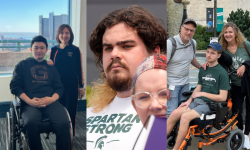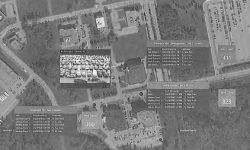MSU offered active violence training. Few attended before shooting

- MSU is moving to make active violence training mandatory
- Records show optional training sessions rarely attended
- Presentations explain how to ‘Run, Hide, Fight’ from shooter
LANSING — Optional active violence training sessions offered by Michigan State University Police were rarely requested and sparsely attended before last month’s mass shooting on campus.
At a school with more than 50,000 students and 13,000 faculty and staff members, an average of 842 people per year attended “Run, Hide, Fight” training sessions between 2019 and 2022, according to university records obtained by Bridge Michigan through a Freedom of Information Act request.
Police used those one- to two-hour sessions to define active violence and mass shootings, explain what to do in an emergency and how to access the university's alert and notification system, according to documents reviewed by Bridge.
- Related:
- MSU shooting survivor: I met ‘pure evil,’ played dead and pleaded for life
- Michigan State faculty worried about door locks 5 months before shooting
- Michigan Senate OKs sweeping gun control reforms after MSU shooting
As a "last resort," students, faculty or staff should "fight” back, according to the training session. "Throw things, yell and work as a team as possible. Commit to your actions -- be aggressive and use improvised weapons."
Campus police have offered similar training sessions since at least 2017, but few students attended. Administrators plan to make them mandatory for all students, faculty and staff after a gunman opened fire in Berkey Hall and the MSU Union on Feb. 13, killing three students and wounding five others.
It's part of an initial plan to "provide more robust security on campus while better preparing our community to respond in these unfortunate situations," MSU Interim President Teresa K. Woodruff said earlier this month.
Like many Michigan colleges, MSU police had offered active violence training sessions upon request from campus groups, organizations and building administrators.
Records show the department hosted 54 training sessions since 2019, averaging about 12 sessions per year through 2022, along with another seven sessions through the first 2 ½ months of 2023.
The trainings were typically requested and provided to faculty and staff groups, but some students attended as well, including a July 2022 virtual training session attended by nearly 1,300 students in the College of Osteopathic Medicine.
All told, at least 3,368 MSU faculty members, staff and students attended active violence training sessions between 2019 and 2022. Another 283 people attended training sessions so far this year.
The records show MSU police conducted three January trainings prior to the Feb. 13 shooting, including a virtual session attended by 45 members of the "MSU community" and an in-person session for 75 student resident assistants.
The records show police held three active violence training sessions at the MSU Union in early 2022 that were attended by a combined 42 people. Police say the gunman killed one student at the Union last month after walking on foot from nearby Berkey Hall, where he killed two others and injured more.
There were no training sessions in Berkey Hall or many of the other academic buildings on campus since 2019, but there were several “virtual training sessions” conducted by Zoom and separate training for staff Emergency Action Teams established in each campus building.
Since the mass shooting, MSU police have conducted three active violence training sessions: For 65 people at the College of Engineering, 20 staffers at the James Madison College and 30 staffers from Office of Financial Aid in the Student Services Building, which is near Berkey Hall.
Students unaware
While MSU Police have a sign-up form and calendar online, many students did not even know the optional training existed, said Delaney Jones, MSU's freshman class student council president.
"I have never heard that before," and even in post-shooting campus conversations with students and faculty members, "I haven't heard anyone mention that they were aware of those," Jones, 18, told Bridge.
Jones said she supports the university decision to make the training sessions mandatory. She added it would make sense to include as part of freshman orientation, where students already go through training on sexual assault and relationship violence prevention and Diversity, Inclusion and Equity.
"This is a serious issue and something that they should be mandating," Jones said.
It’s not yet clear how MSU will provide the mandatory training, which Woodruff has promised to begin this fall. Campus police have begun working with the university's information technology department to figure out a student access solution, police spokesperson Dana Whyte told Bridge on Tuesday.
"That's in the beginning stages still," she said.
In the meantime, any campus group, organization or building can still request an optional training session to be conducted virtually or in-person, Whyte said.
Among other security changes, MSU this month began requiring key card access to most buildings on the East Lansing campus after 6 p.m. each day when fewer staff members trained in active violence scenarios may be in various buildings.
Police say the MSU shooter, 43-year-old Anthony McRae of Lansing, first opened fire at 8:18 p.m. in Berkey Hall, shooting students through the doorway of a night class after entering the unlocked building.
Killed in the attack were Arielle Diamond Anderson, 19, of Harper Woods, Brian Fraser, 20, of Grosse Pointe Park and Alexandria Verner, 20, of Clawson.
MSU plans to install a lock system on all 1,300 campus classrooms and expand its network of more than 2,000 security cameras, which the university was in the process of centralizing to allow real-time monitoring, Woodruff announced on March 1.
Few have mandatory training
The plan would put MSU in select company as one of just a handful of Michigan colleges to make active violence training mandatory.
A recent Bridge Michigan survey found that most Michigan colleges offer such training, but it is typically optional. At some schools, including Oakland Community College and Central Michigan, it is required of all new employees and students.
Several students who spoke to Bridge following last month’s shooting said they hadn't attended violence training sessions at MSU but went through similar training or threats in high school or lower grades so had a general understanding of how to respond.
At a town hall last month, several students called for security upgrades but also expressed fears that going too far could make the school feel like a prison.
So far, the planned policy changes announced by MSU seem to do a "nice job finding that balance," said Jones, the freshman class council president. "The key cards update has been a really nice adjustment because it gives people more of that sense of security without having a police presence at every door."
‘Trust your gut’
In optional training sessions offered this year, MSU police defined active violence as an "ongoing assault with a weapon (not always a gun) that causes serious injury or death of multiple victims within a confined and populated area.
They also shared statistics about mass shootings in which four or more individuals are injured or killed.
"In the first few weeks of 2023, at least 69 people have been killed in mass shootings across the country," read one slide from the PowerPoint presentation obtained by Bridge.
The training sessions directed students and faculty to "mentally rehearse" where they would go in an emergency, and to physically walk various exit routes. Police played a "run, hide, fight" video providing visual directions on what to do during an active violence incident.
Under the "run" category, the police training directed faculty and staff to "figure out" what was happening and then "get out" if possible, leaving belongings behind, or to "call out" using campus or cell phones to describe the specific location of the treat and method of attack.
If running is not an option, the training session directed campus members to "hide" by securing in place, locking or blocking doors, closing blinds and only calling 911 if they could do so without alerting the shooter to their location.
"DO NOT huddle together with others if it can be avoided," because "groups of people make an easy target for the shooter," the presentation continued.
"Only when your life is in danger should you attempt to disrupt and/or incapacitate the active shooter."
It’s unclear whether the training would have made much of a difference for students or faculty on Feb. 13. Police say the shooter moved quickly, opening fire at Berkey Hall at 8:18 p.m. and then again in the MSU union by 8:26 p.m., which was before authorities had sent out their first alert warning students and teachers to run, hide or fight.
In training sessions, MSU Police explained their top priority would be to "stop the threat," before attending to injured persons, evacuating shelter areas, protecting the crime scene and interviewing witnesses or victims.
When law enforcement arrives on the scene, you should "raise your arms," "spread your fingers" and follow officer directions, police said.
To prevent an active violence scenario, the training session directed members of the MSU community to "say something" if they "see something" concerning, including "unusual, bizarre or disturbing behavior" by an individual.
When in doubt, "TRUST YOUR GUT" and report a concerning incident or statement, the training continued, before sharing other resources and guides relevant to an active violence scenario, and taking questions.
Bridge staffer Isabel Lohman contributed
Michigan Education Watch
Michigan Education Watch is made possible by generous financial support from:
Subscribe to Michigan Education Watch
See what new members are saying about why they donated to Bridge Michigan:
- “In order for this information to be accurate and unbiased it must be underwritten by its readers, not by special interests.” - Larry S.
- “Not many other media sources report on the topics Bridge does.” - Susan B.
- “Your journalism is outstanding and rare these days.” - Mark S.
If you want to ensure the future of nonpartisan, nonprofit Michigan journalism, please become a member today. You, too, will be asked why you donated and maybe we'll feature your quote next time!





